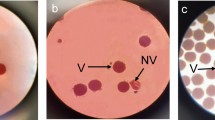Abstract
After application of neutrons on dry seeds ofPisum sativum three recessive mutants were isolated showing irregularities in the course of meiosis. A cytogenetical analysis showed that at metaphase I, a varying number of univalents are formed, most likely as a result of reduced chiasma frequencies. At anaphase I, some univalents divide precociously in mutant 2982 but none do so in mutants 2989 and 2552. As a consequence, most cells of 2989 and 2552 built up more than two spindles at anaphase II, whereas the majority of cells in 2982 form two spindles. This situation is reflected in the frequency distribution of “gones per PMC” at tetrad stage. The discussion deals with the possible causes of univalent formation at meiotic prophase and the variability of univalent behaviour at anaphase I.
Similar content being viewed by others
Literatur
Beadle, G. W. (1933). Further studies of asynaptic maize.Cytologia 4: 269–287.
Enns, H. &E. N. Larter (1962). Linkage relations ofds: a gene governing chromosome behaviour in barley and its effect on genetic recombination.Can. J. Genet. Cytol. 4: 263–266.
Jain, S. K. (1955). Male-sterility in flowering plants.Bibliographia Genet. 18: 101–166.
Klein, H. D. (1968). Die Beeinflussung der Meiosis durch mutierte Gene. Dissertatation Math. Nat. Fak. Univ. Bonn.
Klein, H. D. (1969). Asynapsis and extensive chromosome breakage inPisum. Im Druck.
Levan, A. (1940) The cytology ofAllium amplectens and the occurrence in nature of its asynapsis.Hereditas 26: 353–394.
Moffett, A. A. (1932). Chromosome studies inAnemone. I. A. new type of chiasma behaviour.Cytologia 4: 26–37.
Nayyar, R. P. (1965). Karyotype studies in the genusNetopterus (Lacepede). The occurrence and fate of univalent chromosomes in spermatocytes ofN.chitala. Genetica 36: 398–405.
Östergren, G. I. &E. Vigfusson (1953). On position correlation of univalents and quasi-bivalents formed by sticky univalents.Hereditas 39: 33–50.
Rees, H. (1952). Asynapsis and spontaneous chromosome breakage inScilla.Heredity 26: 353–394.
Riley, R. (1966). Genetics and the regulation of meiotic chromosome behaviour.Sci. Progr. 193–207.
Riley, R., &C. N. Law (1965). Genetic variation in chromosome pairing.Advances in Genetics 13: 57–114.
Ross, J. G., M. E. Sanders &C. J. Franzke (1960). Asynapsis inSorghum.Hereditas 46: 470–480.
Straub, J. (1936). Untersuchungen zur Physiologie der Meiosis. II.Z. Bot. 30: 1–57.
Wagenaar, E. B. (1961). Cytological studies of the development of metaphase I inTriticum hybrids. II. The behaviour of univalents in meiotic cell division.Can. J. Genet. Cytol. 3: 204–225.
Author information
Authors and Affiliations
Rights and permissions
About this article
Cite this article
Klein, H.D. Desynaptische Mutanten mit Unterschieden im Univalentenverhalten. Genetica 40, 566–576 (1969). https://doi.org/10.1007/BF01787381
Received:
Issue Date:
DOI: https://doi.org/10.1007/BF01787381




